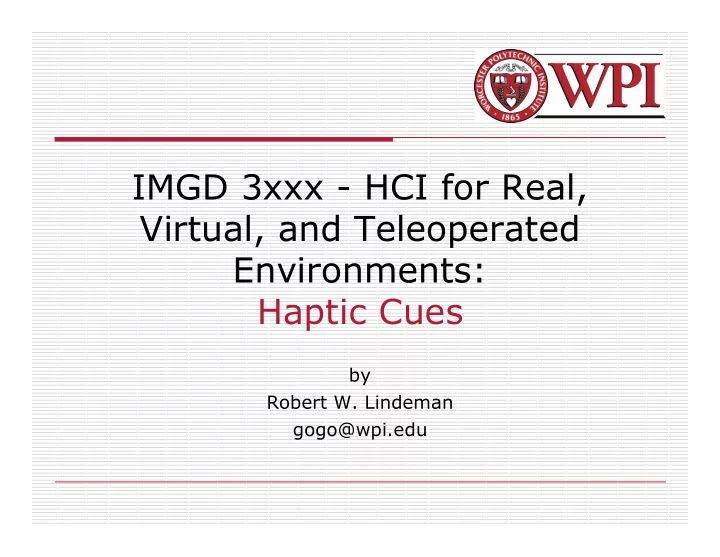

IMGD 3xxx - HCI for Real, Virtual, and Teleoperated Environments: Haptic Cues by Robert W. Lindeman gogo@wpi.edu
Haptic Displays Haptic sense is most complex Tactile Stimuli on the skin Different kinds of mechanoreceptors, each with varying types of sensitivity Temperature Actually part of tactile Kinesthetic Force on the muscles and tendons Proprioception Force feedback Wind Pain R.W. Lindeman - WPI Dept. of Computer Science 2 Interactive Media & Game Development
Haptic Sense The haptic sense is bidirectional Senses the environment Acts on the environment Tight coupling between the two Skin is the largest organ R.W. Lindeman - WPI Dept. of Computer Science 3 Interactive Media & Game Development
Haptic Devices Pin arrays for the finger(s) Force-feedback "arms" "Pager" motors Particle brakes Passive haptics Many devices are application specific Like surgical devices R.W. Lindeman - WPI Dept. of Computer Science 4 Interactive Media & Game Development
Haptic Feedback in VR Tactile: Surface properties Most densely populated area is the fingertip (okay, it's the tongue) Kinesthetic: Muscles, Tendons, etc. Also known as proprioception R.W. Lindeman - WPI Dept. of Computer Science 5 Interactive Media & Game Development
Haptic Sense (cont) Sensitivity varies greatly Body Threshold Distance Site Two-point discrimination Finger 2-3mm Cheek 6mm Nose 7mm Palm 10mm Forehead 15mm Foot 20mm Belly 30mm Forearm 35mm Upper Arm 39mm Back 39mm Shoulder 41mm Thigh 42mm Calf 45mm http://faculty.washington.edu/chudler/chsense.html R.W. Lindeman - WPI Dept. of Computer Science 6 Interactive Media & Game Development
SensAble PHANToM http://www.sensable.com/ R.W. Lindeman - WPI Dept. of Computer Science 7 Interactive Media & Game Development
Immersion CyberGrasp http://www.immersion.com/ R.W. Lindeman - WPI Dept. of Computer Science 8 Interactive Media & Game Development
Passive Haptic Paddle http://www.cs.wpi.edu/~gogo/hive/ R.W. Lindeman - WPI Dept. of Computer Science 9 Interactive Media & Game Development
UNC Being There Project R.W. Lindeman - WPI Dept. of Computer Science 10 Interactive Media & Game Development
Haptic Feedback in VR Virtual contact What should we do when we know that contact has been made with a virtual object? The output of collision detection is the input to virtual contact Cues for understanding the nature of contact with objects are typically over-simplified ( e.g. , sound) Training aids Can we convey additional information using the haptic channel? R.W. Lindeman - WPI Dept. of Computer Science 11 Interactive Media & Game Development
Vibrotactile Cueing Devices Vibrotactile feedback has been incorporated into many devices Can we use this technology to provide scalable, wearable touch cues? R.W. Lindeman - WPI Dept. of Computer Science 12 Interactive Media & Game Development
Vibrotactile Feedback Projects TactaBoard and TactaVest Navy TSAS Project R.W. Lindeman - WPI Dept. of Computer Science 13 Interactive Media & Game Development
Recommend
More recommend